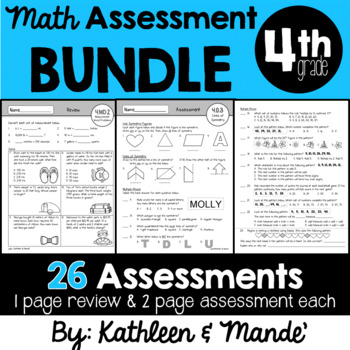4th Grade Math Assessment BUNDLE: 26 Assessments
- Zip
- Easel Activity
What educators are saying
Products in this Bundle (26)
showing 1-5 of 26 products
Description
All of our best selling 4th grade math assessments bundled into one convenient download! Each assessment includes a one page review and two page assessment. Questions are open response and multiple choice.
Save over 10% when purchasing this bundle! :)
Assessments Included:
NBT ~ Numbers & Base Ten Operations
4.NBT.1 & 4.NBT.2 Assessment: Place Value
4.NBT.4 Assessment: Addition & Subtraction
4.NBT.5 Assessment: Multiplication
OA ~ Operations & Algebraic Thinking
4.OA.1 Assessment: Multiplicative Comparisons
4.OA.2 Assessment: Comparison Problems
4.OA.3 Assessment: Multi-Step Operations (Not included at this time....to be added)
4.OA.4 Assessment: Factors & Multiples
NF ~ Numbers & Fraction Operations
4.NF.1 & 4.NF.2 Assessment: Equivalent & Comparing Fractions
4.NF.3 & 4.NF.4 Assessment: Adding, Subtracting, & Multiplying Fractions
4.NF.5 Assessment: Using Tenths and Hundredths
4.NF.6 Assessment: Relating Fractions and Decimals
4.NF.7 Assessment: Compare and Order Decimals
G ~ Geometry
4.G.1 Assessment: Lines & Angles
4.G.2 Assessment: Classify Polygons
4.G.3 Assessment: Lines of Symmetry
MD ~ Measurement & Data
4.MD.1 Assessment: Metric Measurement
4.MD.1 Assessment: Customary Measurement
4.MD.1 Assessment: Mixed Measurement
4.MD.2 Assessment: Measurement Word Problems
4.MD.3 Assessment: Area & Perimeter
4.MD.4 Assessment: Fractional Line Plots
4.MD.5 Assessment: Fractional Parts of a Circle


